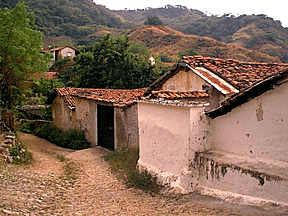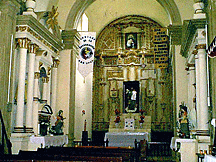I came to Copala to get away from the hustle and bustle of Mazatlan–to
get some peace and quiet in the real Mexico, far from the hoards of
tourists and honking horns. The only sounds I hoped to hear were the
crowing of roosters, the braying of donkeys, and the soft conversations
of residents. In Copola, I found all of that and more. Without question
the village is a retreat for the weary, with not a single stoplight in a
town where wandering donkeys are as numerous as pedestrians.
In Copala the stars are brighter than any place else in Mexico. They
shine on a village set amid the soft green hills of the Sierra Madre
where the wind whispers like the mournful voices of the ghosts of
departed miners who came here by the thousands in search of fortunes in
gold and silver. Then, the bells of the Iglesia San Jose rang out while
the faithful gathered in the square that today is mostly deserted.
At the time Francisco Ibarra, considered the primero minero of
the State of Sinaloa for his discovery of gold and silver deposits
there, crossed the Sierra Madre heading west early in 1564, Copala was
an indigenous village. But as the Spaniards found gold and silver, they
forced the native population to become the miners, so Copala became the
home of the Spanish overseers.
During the last part of the 19th century, Copala was the
center of the region’s silver mining district. Eventually, the mines
closed, and the town became nearly deserted. Today, it's a National
Historic Landmark with 650 full-time residents and a part-time community
of retired Americans and Canadians devoted to the village’s
picturesque solitude.
 After
400 years little has changed here. Caught in the cleavage of the Sierra
Madre Occidental near Mazatlan, it looks like any old Mexican village. A
worn cobblestone road leads to it and is rough on tires. But no one
cares. It discourages traffic.
After
400 years little has changed here. Caught in the cleavage of the Sierra
Madre Occidental near Mazatlan, it looks like any old Mexican village. A
worn cobblestone road leads to it and is rough on tires. But no one
cares. It discourages traffic.
In Copala no one hurries, for there’s nowhere to go. Donkeys, pigs
and chickens wander its narrow cobbled streets. It’s said that there’s
a pig for every person in Copala, which means the motorist must drive
carefully. For like the chickens and the burros, the pigs have the right
of way.
Besides the peacefulness, Copala is possibly the cleanest village in
the Sierra Madres. Built over cliffs, ravines and steep lower slopes,
bougainvillea cascades down the whitewashed walls of houses and spills
off red tile roofs to the narrow, cobblestoned streets, making it look
vaguely like a town in Tuscany.
The village didn’t have electricity until the early 1980s when
ex-President Lopez Portillo ordered electricity delivered to it as a
memorial to his grandfather who’s buried in the village cemetery. The
residents of Copala responded by painting their homes white to honor
Portillo, who attended the dedication.
Yet, Copala appears like a village caught in a time warp.
Wrought-iron lamps line the square–the flatest spot in town. This is
the centerpiece of Copala and a source of civic pride, complete with an
ornate wrought iron bandstand. Shade trees soften the heat and the
brilliance of the sun. Municipal offices and shops border one side while
more shops line the other. A restaurant and inn occupy the third side.
 The small but
massive stone, baroque Iglesia de San Jose, begun in 1748 and completed
in 1775, standing at the far end, dominates the square as the town’s
tallest building and is said to be one of the most beautiful village
churches in Mexico. The traditional white, sage green and gold painted,
vaulted interior adorned with simply polychromed statues, reflects the
rural lifestyle of its parishioners. The dry town fountain, adorned with
a large white goose, occupies a small island in the street in front of
it.
The small but
massive stone, baroque Iglesia de San Jose, begun in 1748 and completed
in 1775, standing at the far end, dominates the square as the town’s
tallest building and is said to be one of the most beautiful village
churches in Mexico. The traditional white, sage green and gold painted,
vaulted interior adorned with simply polychromed statues, reflects the
rural lifestyle of its parishioners. The dry town fountain, adorned with
a large white goose, occupies a small island in the street in front of
it.
From the square I wandered up one of the side streets, admiring the
brilliant bougainvillea blossoms, the ruins of old haciendas, and the
neat white houses. The town's burros, roosters, and dogs provided a
cacophony of background noise while few cars cluttered the streets. I
guess my mind and my auditory sense was somewhat overwhelmed, for I
literally walked right into Bill Clinton. Though I greatly admired him
as U.S. President, this was his alter ego residing in the body of a
gray, braying donkey, topped by a young rider named Jose, which seemed
only natural in a town named San Jose de Copala.
The town revs up around Noon, when tour buses arrive at Daniel’s, a
restaurant on the edge of town founded by Daniel Garrison, an ex-oil
field roustabout from Huntington Beach, California. Soon, visitors
stroll the streets surrounded by small boys selling geodes extracted
from the local hills. Before a road was built to Copala in the 1920s, it
took several weeks to make the journey. Now it’s an easy and scenic
drive from Mazatlan through the nearby village of Concordia. By 3 P.M.,
most of the outsiders depart and the village settles back into
peacefulness.
As the sun began its slide downward, my stomach told me it was time
for my midday comida (lunch), as the aroma of fresh tortillas and
cilantro filled the air.
Back down at the square, I stepped into the Copala Butter Company,
which has nothing to do with the dairy spread. Instead, it’s a small
restaurant and bar, with five rooms to rent–locally known as the
Posada San Jose–that now occupies a 400-year-old structure which is
said to have previously housed the offices of the Butter Mining Company.
For a time, early in the 20th century, the largest mine operator in
the region was Charles Butter, who also owned properties in Colombia,
Nicaragua, South Africa and Australia. His Copala operation included
11,000 acres of lumber and grazing land, 2,000 acres with mineral
deposits, 4 tube mills, a 1,000-horsepower steam boiler, a foundry and
machine shop. Among the most productive on Mexico's West coast, the
Butter mines processed 3,000 tons of gold and silver ore monthly. The
Mexican Revolution took its toll here as elsewhere, though, and the town
also suffered a cholera epidemic and a devastating cyclone. What had
been a city of almost 10,000 shrank to less than a tenth of that in
decades to follow.
I entered the Copala Butter Company through a covered porch, screened
from the outside by brilliant blooming red bougainvillea. I sat at one
of the tables and ordered a cold Mexican beer and their Mexican plato
typico, which comes piled high with homemade tortillas, tacos and
enchiladas, which some say are the best in Mexico. Old photographs and
framed newspaper stories about the Butter Mining Company decorated one
wall of the modest dining area. I noticed a tiny "museum"
containing bits and pieces of old mining paraphernalia through a nearby
doorway. Soon, the waitress brought my meal. After devouring the
enchiladas, I had to agree about them being the best.
Since I decided to stay the night, I inquired about a room from the
man behind the bar.

